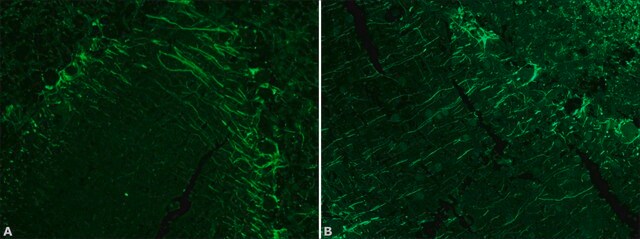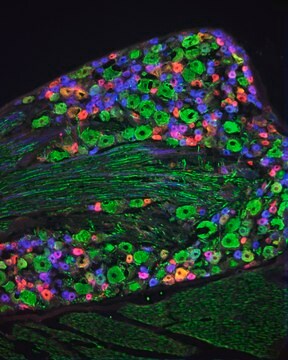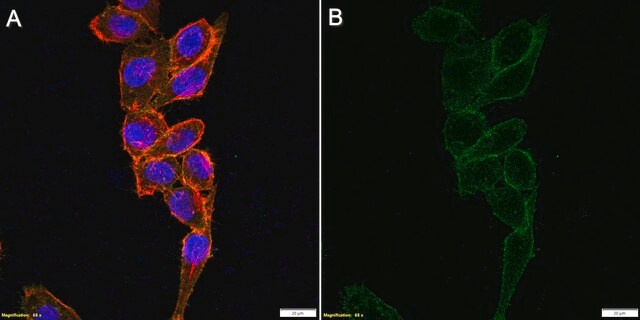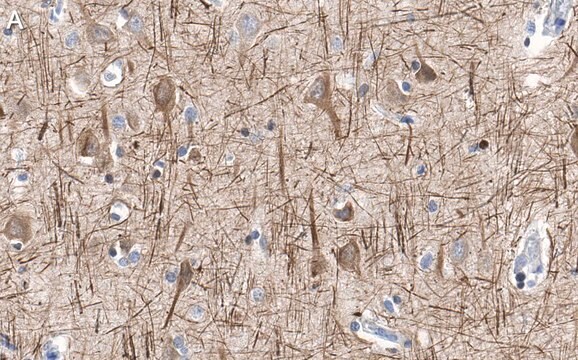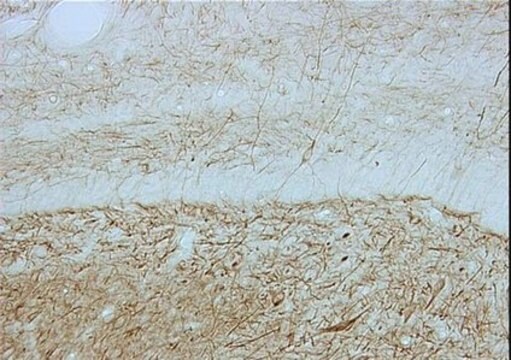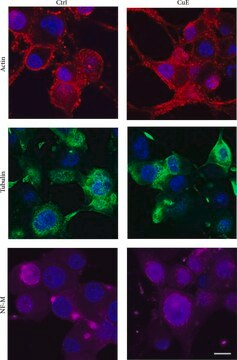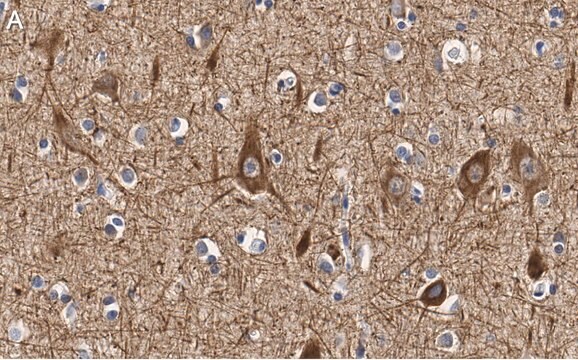推薦產品
生物源
mouse
品質等級
抗體表格
purified from hybridoma cell culture
抗體產品種類
primary antibodies
無性繁殖
NN18, monoclonal
形狀
buffered aqueous solution
分子量
antigen ~160 kDa
濃度
~1.0 mg/mL
技術
immunoblotting: 0.3-0.6 μg/mL using rat brain extract
immunofluorescence: 10-20 μg/mL using human bone marrow neuroblast SHSY5Y cell line
immunohistochemistry: 10-20 μg/mL using heat-retrieved formalin-fixed, paraffin-embedded human brain sections
同型
IgG1
UniProt登錄號
運輸包裝
dry ice
儲存溫度
−20°C
目標翻譯後修改
unmodified
一般說明
Anti-Neurofilament 160 antibody, Mouse monoclonal, (mouse IgG1 isotype) is derived from the NN18 hybridoma produced by the fusion of mouse myeloma cells and splenocytes from mouse immunized with neurofilaments purified from pig spinal cord. Neurofilaments (NFs) belong to the intermediate filament (IF) family and are expressed mainly in cells or tissues of neuronal origin. Three major NFs subunits were discovered: light (NF-L, ~68 kDa), medium (NF-M, ~160 kDa) and heavy (NF-H, ~200 kDa), which are themselves composed of two tetrameric protofilament complexes of monomeric proteins. Neurofilament 160, also known as NF-M or Neurofilament triplet M protein.
免疫原
neurofilaments purified from pig spinal cord
應用
Anti-Neurofilament 160 antibody has been used in immunoblotting, Immunohistochemistry, Immunofluorescence
生化/生理作用
NFs can accumulate in large numbers within cell bodies and proximal axons of affected neurons in a variety of pathologies, including Charcot-Marie-Tooth disease (CMT), neurofilament inclusion disease (NFID), giant axonal neuropathy (GAN), diabetic neuropathy, spinal muscular atrophy (SMA) and spastic paraplegia. In addition, NFs accumulation were detected in Alzheimer′s (AD) and Parkinson′s disease (PD) patients. Elevated concentrations of Neurofilament 160 have been shown in cerebrospinal fluid (CSF) and serum samples from patients with brain injury.
外觀
Solution in 0.01 M phosphate buffered saline, pH 7.4, containing 15 mM sodium azide.
未找到適合的產品?
試用我們的產品選擇工具.
儲存類別代碼
10 - Combustible liquids
閃點(°F)
Not applicable
閃點(°C)
Not applicable
M M Black et al.
The Journal of neuroscience : the official journal of the Society for Neuroscience, 8(9), 3296-3305 (1988-09-01)
The principal subunits of neurofilaments (NFs) of immature cultured sympathetic neurons have apparent Mr of 68,000 and 145,000; a 200,000 Mr subunit is also present, but at comparatively low levels. These subunits are referred to as the low (NFL), middle
G Shaw et al.
Brain research, 460(2), 227-234 (1988-09-20)
Previous immunocytochemical studies have shown immunological differences between neurofilaments in axons and those in dendrites and perikarya of many mature neuron types: it is now known that non-phosphorylated epitopes are normally seen in cell bodies and dendrites of mature neurons
M J Monteiro et al.
The Journal of cell biology, 108(2), 579-593 (1989-02-01)
We have used transient and stable DNA transfection to force synthesis of the mouse NF-L and NF-M genes in nonneuronal cultured animal cells. When the authentic NF-L gene (containing 1.7 kb of sequences 5' to the transcription initiation site) was
Eduardo Martínez-Morillo et al.
Clinical chemistry and laboratory medicine, 53(10), 1575-1584 (2015-02-27)
Brain injury is a medical emergency that needs to be diagnosed and treated promptly. Several proteins have been studied as biomarkers of this medical condition. The aims of this study were to: 1) evaluate the selectivity and precision of a
Elevated neurofilament levels in neurological diseases
Norgren N, et al.
Brain Research, 987(1), 25-31 (2003)
我們的科學家團隊在所有研究領域都有豐富的經驗,包括生命科學、材料科學、化學合成、色譜、分析等.
聯絡技術服務